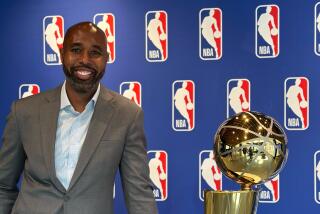Enforcement Is Not Easy--NCAA Director
- Share via
MISSION, Kan. — The third man to head the NCAA enforcement department hopes not to be the last.
But Steve Morgan believes his job may go the way of the buggy whip-maker if corrections are not made soon in the troubled landscape of college sports. It’s a conclusion based on his belief that the NCAA’s efforts to enforce the rules of amateurism have been, for the most part, a failure.
“I wouldn’t say that we have been a total failure,” Morgan said. “But I do think this may be our last shot at having an enforcement program the membership believes in and will support. If we fail at this point and the membership loses confidence in us and the public cynicism prevails, it may be time to chuck the rules of amateurism and just take an anything-goes approach.”
The 37-year-old Morgan officially took charge of the renamed, revamped arm of the ruling body of collegiate athletics in October. It is no longer the NCAA Enforcement Department. It is now the NCAA Enforcement and Compliance Department.
The newly created compliance section will employ four full-time staffers to help schools live within the rules and avoid the greatly stiffened penalties awaiting violators as a result of the NCAA’s special convention last summer. In addition, two full-time field investigators are being added to the staff of 10.
The compliance unit will address a major point on Morgan’s agenda--to reduce the adversary relationship between the NCAA and member schools.
“If we can’t turn the black hat white, maybe we can at least turn it a shade of gray,” Morgan said. “We want to get to where the membership feels comfortable and knows there are people here who are interested in helping them, not just busting them.”
Morgan also hopes the compliance department will help dispel what he calls the NCAA’s “cloak of mystery.”
“We will certainly have to maintain our confidentiality as to specific cases,” he said. “But I hope we can shake off some of the mystique of the enforcement efforts and the department itself and show schools that there is a group of people here they can turn to if they feel like they’ve got a bad situation. If they’re trying to figure out how to gain proper institutional control and how to monitor their booster groups, we’ll have a group of people who are here to help them do that very thing. Then maybe we can convince the members that we’re really here to help and not as a secret-agent force.”
The biggest headache, coaches and administrators say, is the over-zealous fan who pitches in to help recruit the top athletes. NCAA schools voted two years ago to outlaw boosters from recruiting off-campus. The Southwest Conference, hit by the revelations at Texas Christian and the recent SMU probation, will offer a proposal at the NCAA convention in January that would make it illegal for boosters to help recruit on-campus.
The new penalty structure adopted at the special June convention is radical, indeed. Infractions that once drew private reprimands can now result in forfeiture of games, ineligibility of players and the banning of a head coach and others from off-campus recruiting for a year.
For major violations, mandatory penalties include the elimination of all expense-paid visits by recruits for at least one year; the banning of all coaches in the affected sport from off-campus recruiting; and the termination or reassignment of all coaches or staff members who knowingly engaged in or condoned rule-breaking.
A school found guilty of major violations twice within a five-year period can be forced to suspend the last penalized sport for up to two years. This has been dubbed the “Death Penalty” for the affect people believe it would have on a program.
Morgan pointed out that the schools, led by a group of influential college presidents, voted these new rules upon themselves with only three dissenters. It amounts, he said, to a mandate from the membership.
“What has been missing, at least until recently, is a clear commitment on the part of the membership that they want things restored to order, that they want a significant enforcement effort to assist those institutions who want to comply,” he said.
Morgan figures it will be several years before anyone can say definitely whether the “initiatives of 1985” have been a success or a failure.
“But if we look back and see that nothing has happened and the confidence has dissipated and the public perception continues to be one of cynicism, then we’ll have to look hard to see if there’s any value in continuing to go after it from this direction. I still think it’s possible, or I wouldn’t have taken this on.”
More to Read
Go beyond the scoreboard
Get the latest on L.A.'s teams in the daily Sports Report newsletter.
You may occasionally receive promotional content from the Los Angeles Times.










